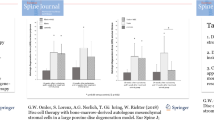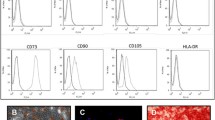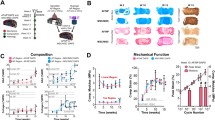Abstract
Purpose
Cell therapy would be favorably performed immediately after nucleotomy, to restore intervertebral disc functionality and to slow down disc degeneration. Promising results were reported from small animal models but remaining problems, especially in larger animals, include loss of vital cells due to annular damage at the injection site and detrimental intradiscal conditions. The aim of the present study was to optimize cell-based disc therapy using a new albumin–hyaluronan hydrogel together with bone marrow-derived mesenchymal stem cells in a large porcine disc model.
Methods
Luciferase cell labeling was evaluated to follow-up stem cells metabolically up to 7 days in 3D cell cultures mimicking the harsh disc environment with low oxygen and glucose concentrations. As a pilot in vivo study, the implant was injected into porcine discs after removal of ~10 % of nucleus volume and animals were killed immediately after surgery (n = 6) and 3 days later (n = 6). 24 discs were analyzed. Implant persistence and cell activity (luciferase + WST assay) were observed simultaneously.
Results
In vitro cell culture with reduction of glucose (20, 5, 0.5, 0 mM) and oxygen (21, 5, 2 %) significantly decreased metabolic cell activity and luciferase activity after 3 days, with no recovery and a further decrease after 7 days, establishing luciferase activity as a metabolic sensor. During 3 days of 3D culture with disc-like conditions, luciferase activity decreased to 8 %. In vivo, initial implant volume shrank to 61 % at day 3 with evidence for hydrogel compression. Luciferase activity in vivo at day 3 was 2 % without referencing but 23 % after referencing to in vitro cell adaptation, and 38 % after additional consideration of detected implant volume loss.
Conclusion
In vitro analysis up to 7 days established for the first time luciferase activity as a metabolic sensor for mesenchymal stem cells used in regenerative disc therapy. Under the present protocol, short-term in vivo analysis after 3 days suggests improved implant retainment inside the disc and persistence of metabolically active cells; however, further studies will have to prove long-term in vivo outcome.






Similar content being viewed by others
References
Lyons G, Eisenstein SM, Sweet MB (1981) Biochemical changes in intervertebral disc degeneration. Biochim Biophys Acta 673:443–453
Benneker LM, Heini PF, Alini M, Anderson SE, Ito K (2005) 2004 Young investigator award winner: vertebral endplate marrow contact channel occlusions and intervertebral disc degeneration. Spine 30:167–173
Chanchairujira K, Chung CB, Kim JY, Papakonstantinou O, Lee MH, Clopton P, Resnick D (2004) Intervertebral disk calcification of the spine in an elderly population: radiographic prevalence, location, and distribution and correlation with spinal degeneration. Radiology 230:499–503
Freemont AJ, Watkins A, Le Maitre C, Jeziorska M, Hoyland JA (2002) Current understanding of cellular and molecular events in intervertebral disc degeneration: implications for therapy. J Pathol 196:374–379
Grunhagen T, Wilde G, Soukane DM, Shirazi-Adl SA, Urban JP (2006) Nutrient supply and intervertebral disc metabolism. J Bone Jt Surg Am 88(2):30–35
Guiot BH, Fessler RG (2000) Molecular biology of degenerative disc disease. Neurosurgery 47:1034–1040
Omlor GW, Lorenz H, Engelleiter K, Richter W, Carstens C, Kroeber MW, Guehring T (2006) Changes in gene expression and protein distribution at different stages of mechanically induced disc degeneration—an in vivo study on the New Zealand white rabbit. J Orthop Res 24:385–392
Omlor GW, Nerlich AG, Wilke HJ, Pfeiffer M, Helga Lorenz, Schaaf-Keim M, Bertram H et al (2009) A new porcine in vivo animal model of disc degeneration—response of annulus fibrosus cells, chondrocyte-like nucleus pulposus cells and notochordal nucleus pulposus cells to partial nucleotomy. Spine 34(25):2730–2739
Pfirrmann CW, Metzdorf A, Elfering A, Hodler J, Boos N (2006) Effect of aging and degeneration on disc volume and shape: a quantitative study in asymptomatic volunteers. J Orthop Res 24:1086–1094
Rajasekaran S, Venkatadass K, Naresh Babu J, Ganesh K, Shetty AP (2008) Pharmacological enhancement of disc diffusion and differentiation of healthy, ageing and degenerated discs. Results from in vivo serial post-contrast MRI studies in 365 human lumbar discs. Eur Spine J 17:626–643
Setton LA, Chen J (2006) Mechanobiology of the intervertebral disc and relevance to disc degeneration. J Bone Jt Surg Am 88(Suppl 2):52–57
Moore RJ (2006) The vertebral endplate: disc degeneration, disc regeneration. Eur Spine J 15(Suppl 3):333–337
Boos N, Weissbach S, Rohrbach H, Weiler C, Spratt KF, Nerlich AG (2002) Classification of age related changes in lumbar intervertebral discs: 2002 Volvo award in basic science. Spine 27:2631–2644
Le Maitre CL, Freemont AJ, Hoyland JA (2007) Catabolic cytokine expression in degenerate and herniated human intervertebral discs: IL-1b and TNFα expression profile. Arthr Res Ther 9:77
Burke JG, Watson RW, McCormack D, Dowling FE, Walsh MG, Fitzpatrick JM (2002) Intervertebral discs which cause low back pain secrete high levels of proinflammatory mediators. J Bone Jt Surg Br 84:196–201
Shamji MF, Setton LA, Jarvis W, So S, Chen J, Jing L, Bullock R, Isaacs RE, Brown C, Richardson WJ (2010) Proinflammatory cytokine expression profile in degenerated and herniated human intervertebral disc tissues. Arthr Rheum 62:1974–1982
Battié MC, Videman T, Kaprio J, Gibbons LE, Gill K, Manninen H, Saarela J, Peltonen L (2009) The twin spine study: contributions to a changing view of disc degeneration. Spine J 9:47–59
Livshits G, Popham M, Malkin I, Sambrook PN, Macgregor AJ, Spector T, Williams FM (2011) Lumbar disc degeneration and genetic factors are the main risk factors for low back pain in women: the UK twin spine study. Ann Rheum Dis 70:1740–1745
Atlas SJ, Keller RB, Wu YA, Deyo RA, Singer DE (2005) Long-term outcomes of surgical and nonsurgical management of sciatica secondary to a lumbar disc herniation: 10 year results from the Maine lumbar spine study. Spine 30:927–935
Choy DS (2000) Familial incidence of intervertebral disc herniation: an hypothesis suggesting that laminectomy and discectomy may be counterproductive. J Clin Laser Med Surg 18:29–32
Carragee EJ, Han MY, Suen PW, Kim D (2003) Clinical outcomes after lumbar discectomy for sciatica: the effects of fragment type and anular competence. J Bone Jt Surg Am 85-A:102–108
Hegewald AA, Ringe J, Sittinger M, Thome C (2008) Regenerative treatment strategies in spinal surgery. Front Biosci 13:1507–1525
Bron JL, Helder MN, Meisel HJ, Van Royen BJ, Smit TH (2009) Repair, regenerative and supportive therapies of the annulus fibrosus: achievements and challenges. Eur Spine J 18:301–313
Omlor GW, Nerlich AG, Lorenz H, Bruckner T, Richter W, Pfeiffer M, Gühring T (2012) Injection of a polymerized hyaluronic acid/collagen hydrogel matrix in an in vivo porcine disc degeneration model. Eur Spine J 21:1700–1708
Meisel HJ, Ganey T, Hutton WC, Libera J, Minkus Y, Alasevic O (2006) Clinical experience in cell based therapeutics: intervention and outcome. Eur Spine J 15(3):397–405
Gruber HE, Johnson TL, Leslie K, Ingram JA, Martin D, Hoelscher G, Banks D et al (2002) Autologous intervertebral disc cell implantation: a model using Psammomys obesus, the sand rat. Spine 27:1626–1633
Sato M, Asazuma T, Ishihara M, Ishihara M, Kikuchi T, Kikuchi M, Fujikawa K (2003) An experimental study of the regeneration of the intervertebral disc with an allograft of cultured annulus fibrosus cells using a tissue-engineering method. Spine 28:548–553
Wei A, Tao H, Chung SA, Brisby H, Ma DD, Diwan AD (2009) The fate of transplanted xenogeneic bone marrowderived stem cells in rat intervertebral discs. J Orthop Res 27:374–379
Sakai D, Mochida J, Iwashina T, Watanabe T, Nakai T, Ando K, Hotta T (2005) Differentiation of mesenchymal stem cells transplanted to a rabbit degenerative disc model: potential and limitations for stem cell therapy in disc regeneration. Spine 30:2379–2387
Sakai D, Mochida J, Iwashina T, Hiyama A, Omi H, Imai M, Nakai T et al (2006) Regenerative effects of transplanting mesenchymal stem cells embedded in atelocollagen to the degenerated intervertebral disc. Biomaterials 27:335–345
Zhang YG, Guo X, Xu P, Kang LL, Li J (2005) Bone mesenchymal stem cells transplanted into rabbit intervertebral discs can increase proteoglycans. Clin Orthop Relat Res 430:219–226
Paesold G, Nerlich AG, Boos N (2007) Biological treatment strategies for disc degeneration: potentials and shortcomings. Eur Spine J 16:447–468
Henriksson HB, Svanvik T, Jonsson M, Hagman M, Horn M, Lindahl A, Brisby H (2009) Transplantation of human mesenchymal stems cells into intervertebral discs in a xenogeneic porcine model. Spine 34:141–148
Omlor GW, Bertram H, Kleinschmidt K, Fischer J, Brohm K, Guehring T, Anton M, Richter W (2010) Methods to monitor distribution and metabolic activity of mesenchymal stem cells following in vivo injection into nucleotomized porcine intervertebral discs. Eur Spine J 19:601–612
Reitmaier S, Kreja L, Gruchenberg K, Kanter B, Silva-Correia J, Oliveira JM, Reis RL et al (2013) In vivo biofunctional evaluation of hydrogels for disc regeneration. Eur Spine J [Epub ahead of print]
Benz K, Stippich C, Osswald C, Gaissmaier C, Lembert N, Badke A, Steck E et al (2012) Rheological and biological properties of a hydrogel support for cells intended for intervertebral disc repair. BMC Musculoskelet Disord 13:54
Scholz B, Kinzelmann C, Benz K, Mollenhauer J, Wurst H, Schlosshauer B (2010) Suppression of adverse angiogenesis in an albumin-based hydrogel for articular cartilage and intervertebral disc regeneration. Eur Cell Mater 20:24–36
Benz K, Stippich C, Fischer L, Möhl K, Weber K, Lang J, Steffen F et al (2012) Intervertebral disc cell- and hydrogel-supported and spontaneous intervertebral disc repair in nucleotomized sheep. Eur Spine J 21:1758–1768
Parfitt AM, Drezner MK, Glorieux FH, Kanis JA, Malluche H, Meunier PJ, Ott SM et al (1987) Bone histomorphometry: standardization of nomenclature, symbols, and units. Report of the ASBMR histomorphometry nomenclature committee. J Bone Miner Res 2:595–610
Singer NG, Caplan AI (2011) Mesenchymal stem cells: mechanisms of inflammation. Annu Rev Pathol 6:457–478
Jiang XX, Zhang Y, Liu B, Zhang SX, Wu Y, Yu XD, Mao N (2005) Human mesenchymal stem cells inhibit differentiation and function of monocyte-derived dendritic cells. Blood 105:4120–4126
Hochberg MC (2000) Role of intra-articular hyaluronic acid preparations in medical management of osteoarthritis of the knee. Semin Arthr Rheum 30:2–10
Goa KL, Benfield P (1994) Hyaluronic acid. A review of its pharmacology and use as a surgical aid in ophthalmology and its therapeutic potential in joint disease and wound healing. Drugs 47:536–566
Key JA, Ford LT (1948) Experimental intervertebral-disc lesions. J Bone Jt Surg Am 30:621–630
Korecki CL, Costi JJ, Iatridis JC (2008) Needle puncture injury affects intervertebral disc mechanics and biology in an organ culture model. Spine 33:235–241
Wilke HJ, Heuer F, Neidlinger-Wilke C, Claes L (2006) Is a collagen scaffold for a tissue engineered nucleus replacement capable of restoring disc height and stability in an animal model? Eur Spine J 15(Suppl 3):433–438
Heuer F, Ulrich S, Claes L, Wilke HJ (2008) Biomechanical evaluation of conventional anulus fibrosus closure methods required for nucleus replacement. Laboratory investigation. J Neurosurg Spine 9:307–313
Wuertz K, Godburn K, Neidlinger-Wilke C, Urban J, Iatridis JC (2008) Behavior of mesenchymal stem cells in the chemical microenvironment of the intervertebral disc. Spine 33:1843–1849
Kanichai M, Ferguson D, Prendergast PJ, Campbell VA (2008) Hypoxia promotes chondrogenesis in rat mesenchymal stem cells: a role for AKT and hypoxia-inducible factor (HIF)-1α. J Cell Physiol 216:708–715
Bai X, Yan Y, Song YH, Seidensticker M, Rabinovich B, Metzele R, Bankson JA et al (2010) Both cultured and freshly isolated adipose tissue-derived stem cells enhance cardiac function after acute myocardial infarction. Eur Heart J 31:489–501
Dégano IR, Vilalta M, Bagó JR, Matthies AM, Hubbell JA, Dimitriou H, Bianco P et al (2008) Bioluminescence imaging of calvarial bone repair using bone marrow and adipose tissue-derived mesenchymal stem cells. Biomaterials 29:427–437
Holm S, Maroudas A, Urban JP, Selstam G, Nachemson A (1981) Nutrition of the intervertebral disc: solute transport and metabolism. Connect Tissue Res 8:101–119
Bartels EM, Fairbank JC, Winlove CP, Urban JP (1998) Oxygen and lactate concentrations measured in vivo in the intervertebral discs of patients with scoliosis and back pain. Spine 23:1–7
Bibby SR, Urban JP (2004) Effect of nutrient deprivation on the viability of intervertebral disc cells. Eur Spine J 13:695–701
Balasubramanyam A, Sailaja N, Mahboob M, Rahman MF, Hussain SM, Grover P (2009) In vivo genotoxicity assessment of aluminium oxide nanomaterials in rat peripheral blood cells using the comet assay and micronucleus test. Mutagenesis 24:245–251
Zhang Q, Xu L, Wang J, Sabbioni E, Piao L, Di Gioacchino M, Niu Q (2013) Lysosomes involved in the cellular toxicity of nano-alumina: combined effects of particle size and chemical composition. J Biol Regul Homeost Agents 27:365–375
Risbud MV, Albert TJ, Guttapalli A, Vresilovic EJ, Hillibrand AS, Vaccaro AR, Shapiro IM (2004) Differentiation of mesenchymal stem cells towards a nucleus pulposus-like phenotype in vitro: implications for cell-based transplantation therapy. Spine 29:2627–2632
Mylotte LA, Duffy AM, Murphy M, O’Brien T, Samali A, Barry F, Szegezdi E (2008) Metabolic flexibility permits mesenchymal stem cell survival in an ischemic environment. Stem Cells 26:1325–1336
Wuertz K, Godburn K, Iatridis JC (2009) MSC response to pH levels found in degenerating intervertebral discs. Biochem Biophys Res Commun 379:824–829
Dexheimer V, Frank S, Richter W (2012) Proliferation as a requirement for in vitro chondrogenesis of human mesenchymal stem cells. Stem Cells Dev 21:2160–2169
Sobajima S, Vadala G, Shimer A, Kim JS, Gilbertson LG, Kang JD (2008) Feasibility of a stem cell therapy for intervertebral disc degeneration. Spine J 8:888–896
Acknowledgments
We would like to thank S. Gantz for statistical support, J. Mollenhauer and K. Gaissmaier from TETEC AG for technical support, providing us with samples of the hydrogel implant and critically reading the manuscript, and V. Kraemer from Friatec AG for samples of Degussit. The study was funded by BioProfile Grant 0313755 and Grant 0315579 from the Ministry of Education and Research, Germany. Also parts of this work were financially supported by the Orthopaedic University hospital.
Conflict of interest
None of the authors has any potential conflict of interest.
Author information
Authors and Affiliations
Corresponding author
Additional information
G. W. Omlor and J. Fischer share first authorship.
Rights and permissions
About this article
Cite this article
Omlor, G.W., Fischer, J., Kleinschmitt, K. et al. Short-term follow-up of disc cell therapy in a porcine nucleotomy model with an albumin–hyaluronan hydrogel: in vivo and in vitro results of metabolic disc cell activity and implant distribution. Eur Spine J 23, 1837–1847 (2014). https://doi.org/10.1007/s00586-014-3314-y
Received:
Revised:
Accepted:
Published:
Issue Date:
DOI: https://doi.org/10.1007/s00586-014-3314-y




